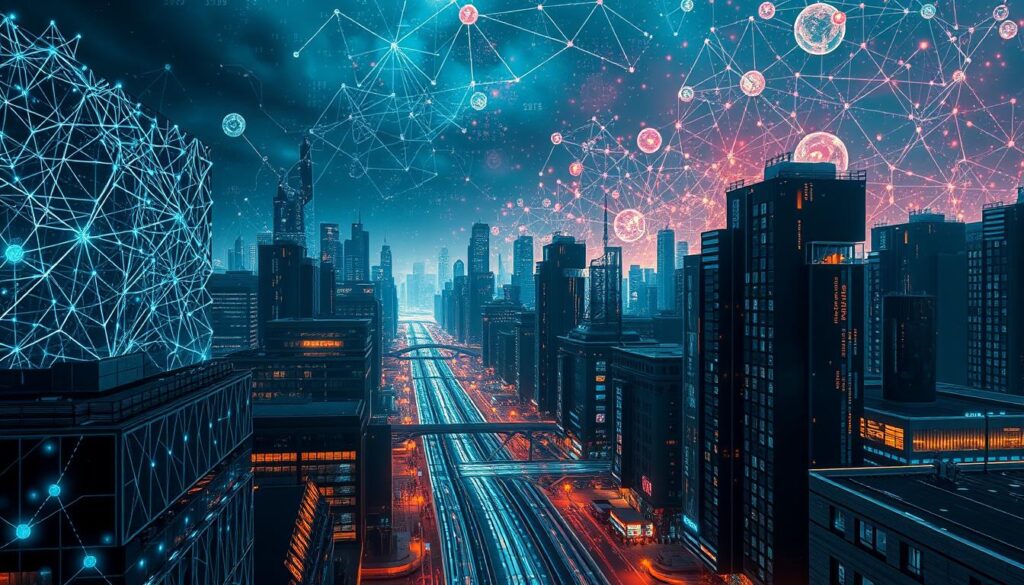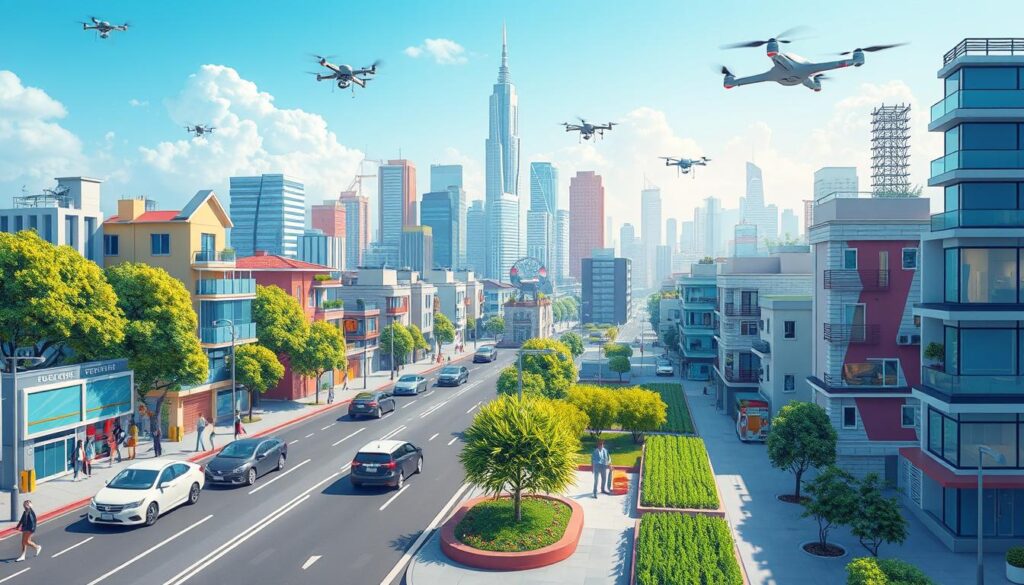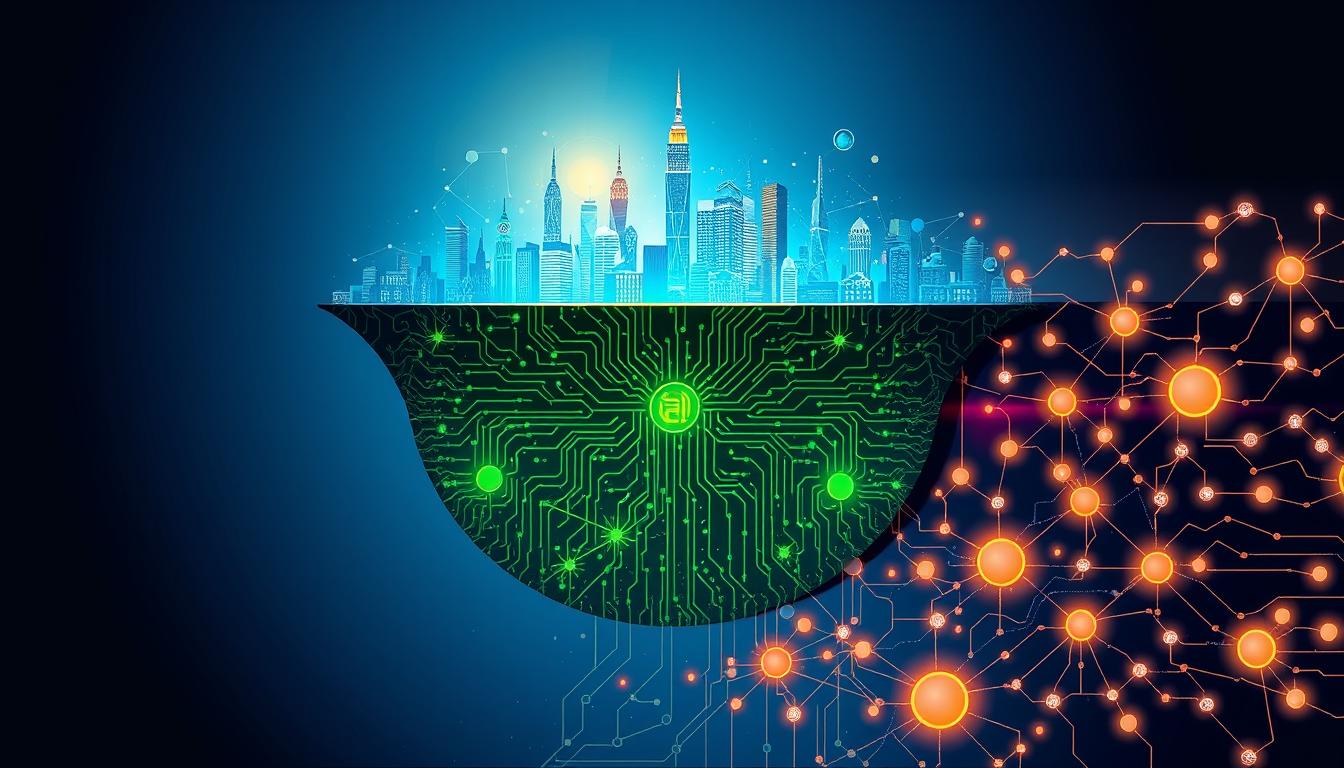In today’s fast-changing tech world, “artificial intelligence” (AI), “machine learning,” and “deep learning” are often mixed up. But they are actually different ideas with their own special traits. This article will dive into what makes each one unique, covering their meanings, uses, and how they relate to each other.
Key Takeaways
- Artificial intelligence (AI) is a wide field that aims to create smart systems that can do things humans usually do.
- Machine learning is a part of AI that lets systems get better with practice, without needing to be told how.
- Deep learning is a type of machine learning that uses artificial neural networks to handle and understand complex data.
- The main differences between AI, machine learning, and deep learning are in how they solve problems, what data they need, and how much human help they require.
- Knowing the differences between these areas is key for businesses and people to choose the right tech for their needs.
Introduction to Artificial Intelligence
Artificial intelligence (AI) is a field that could change our world a lot. It makes computer systems and algorithms that can do things humans do, like solve problems and recognize patterns.
What is Artificial Intelligence?
AI is a wide field that includes many technologies and methods. It lets machines learn, understand, and adapt like humans do. AI systems can handle lots of data, find patterns, and make smart choices, often better than humans in certain areas.
Applications of AI in Various Industries
Artificial intelligence affects many industries in big ways. In healthcare, AI helps diagnose diseases, develop drugs, and create personalized treatments. In finance, AI changes fraud detection, investment analysis, and risk management. Transportation uses AI for self-driving cars, better traffic flow, and logistics.
AI also changes customer service, marketing, and cybersecurity. It helps businesses work better and serve customers more effectively.
As AI keeps growing, it opens up new chances to improve our lives. By using AI, we can create a future where technology and human smarts work together perfectly.
The Difference Between Artificial Intelligence, Machine Learning, and Deepest
Artificial intelligence (AI), machine learning, and deep learning are often confused with each other. But they are actually different concepts with unique features. Knowing the differences between these terms helps us understand modern technology better.
AI is the big umbrella that covers systems that can do things humans usually do, like solving problems and making decisions. Machine learning is a part of AI that lets systems get better with data, even without being told how. Deep learning is a special part of machine learning that uses artificial neural networks to handle complex data.
The main difference is how much human help is needed. AI systems can do tasks but don’t get better on their own. Machine learning models can get better with data. Deep learning can find deep insights in big data without needing a lot of human help.
| Characteristic | Artificial Intelligence | Machine Learning | Deep Learning |
|---|---|---|---|
| Definition | The broad field of creating systems capable of performing tasks that typically require human intelligence | A subset of AI that focuses on the ability of systems to learn and improve from data without being explicitly programmed | A specialized form of machine learning that utilizes artificial neural networks to process and analyze complex data |
| Approach | Programmed to perform specific tasks | Adapts and enhances performance based on data | Discovers deeper patterns and insights within large, unstructured datasets |
| Human Intervention | Requires significant human intervention | Requires less human intervention compared to traditional AI | Requires minimal human intervention, with the system learning on its own |
By knowing the differences between AI, machine learning, and deep learning, we can better use these technologies. They help solve complex problems in many industries.
Machine Learning: A Subset of AI
Machine learning is a key part of artificial intelligence. It helps computers learn from data without being told how. This has changed many fields, like healthcare and finance, by making complex decisions and finding important insights.
Supervised vs Unsupervised Learning
Machine learning has two main types: supervised and unsupervised learning. Supervised learning uses labeled data to teach algorithms. They learn to predict new data based on what they’ve seen before. Unsupervised learning works with data without labels. It finds patterns and structures that weren’t known before.
| Supervised Learning | Unsupervised Learning |
|---|---|
|
|
Both supervised and unsupervised learning have their uses. The choice depends on the data and what you want to achieve. Each method has its own strengths and fits different problems.
“Machine learning is the field of study that gives computers the ability to learn without being explicitly programmed.”
– Arthur Samuel, pioneer of machine learning
Deep Learning: A Subset of Machine Learning
Deep learning is a cutting-edge part of machine learning. It uses artificial neural networks with many hidden layers to understand and process data. It builds on traditional machine learning to solve more complex issues.
Unlike traditional machine learning, deep learning doesn’t need manual feature engineering. It can automatically learn from raw data. This is thanks to deep neural networks, which are like the human brain.
The main difference is the depth of the neural network. Machine learning models are shallow, while deep learning models have dozens or hundreds of layers. This lets them learn complex data representations.
This depth helps deep learning shine in tasks like image recognition, natural language processing, and speech recognition. These tasks have complex patterns that traditional machine learning can’t handle.

Deep learning uses deep neural networks to learn detailed data representations. This makes it a powerful tool for solving tough problems. It’s a key part of modern artificial intelligence, driving progress in many fields.
AI vs Machine Learning: Key Distinctions
Artificial intelligence (AI) and machine learning (ML) are related but different. They vary in data needs and problem-solving methods. Let’s look at these differences to understand each technology’s unique traits.
Data Requirements
AI needs big, detailed datasets to work well. It requires lots of information to learn and make good decisions. Machine learning, however, can do great with smaller, focused datasets. ML is good at finding patterns in specific data, solving narrow problems.
Approach to Problem-Solving
The problem-solving approach in AI and ML is different. AI tries to be like humans, understanding problems deeply. It uses complex algorithms and neural networks for this. Machine learning, on the other hand, finds patterns in data without needing to understand the problem deeply.
“The key distinction between AI and machine learning lies in their approach to problem-solving. While AI strives to emulate human intelligence, machine learning excels at pattern recognition and data-driven decision-making.”
Knowing these differences helps businesses and individuals choose the right technology. Whether it’s AI vs. machine learning, or the data requirements for AI vs. machine learning, or the problem-solving approach in AI vs. machine learning, understanding each technology’s strengths is key.
Machine Learning vs Deep Learning: Similarities and Differences
Exploring artificial intelligence, we find a key difference between machine learning and deep learning. Both are part of AI, but they use different methods and structures. This makes them unique in their own ways.
Algorithms and Architectures
Machine learning uses traditional statistical methods like linear regression and decision trees. These methods help find patterns and make predictions from data. They are simpler and need less power compared to deep learning.
Deep learning, however, uses artificial neural networks, inspired by the human brain. These networks are complex and can automatically find important features in data. They are great at solving tough problems, like recognizing images and understanding speech.
| Characteristic | Machine Learning | Deep Learning |
|---|---|---|
| Algorithms | Traditional statistical algorithms (e.g., linear regression, decision trees, random forests) | Artificial neural networks (e.g., CNNs, RNNs) |
| Complexity | Simpler and less computationally intensive | More complex and computationally intensive |
| Feature Engineering | Requires manual feature extraction | Automatically learns features from raw data |
| Performance on Complex Tasks | Typically less effective | Highly effective, especially on tasks like image recognition and natural language processing |
Knowing the differences in algorithms and structures helps us understand their strengths and weaknesses. This knowledge guides us in choosing the right tool for AI tasks. It helps us make better decisions in our AI projects.
Real-World Applications: AI, Machine Learning, and Deep Learning
Artificial Intelligence (AI), machine learning, and deep learning are changing the world. They help solve big problems and bring new ideas to life. Let’s look at some cool ways these technologies are making a difference.
In healthcare, AI and machine learning help doctors find diseases early and plan treatments better. Deep learning looks at medical images like X-rays with amazing accuracy. This helps find cancer and other serious conditions.
| Industry | AI/ML/DL Application | Business Impact |
|---|---|---|
| Finance | Fraud detection, investment portfolio optimization, credit risk assessment | Reduced financial losses, improved investment returns, more accurate lending decisions |
| Retail | Personalized product recommendations, demand forecasting, inventory optimization | Increased customer satisfaction, improved operational efficiency, higher sales |
| Automotive | Autonomous driving, predictive maintenance, vehicle safety systems | Improved transportation safety, reduced operating costs, enhanced user experience |
In transportation, AI is making self-driving cars a reality. Deep learning lets these cars handle tough roads and make smart choices. This could make travel safer and more efficient.
These examples show how AI, machine learning, and deep learning are changing our world. As they keep getting better, we’ll see even more amazing things that make our lives better.

“The real power of AI will be the ability to harness data in new ways to improve people’s lives.”
– Satya Nadella, CEO of Microsoft
Challenges and Limitations
Exploring artificial intelligence (AI), machine learning, and deep learning reveals their challenges and limits. These technologies offer great benefits but also raise ethical and practical issues. These concerns can affect how they are used in real life.
Ethical Considerations
Ethics is a major concern with AI, machine learning, and deep learning. These technologies can make choices that affect people’s lives. It’s important that these choices are fair and unbiased. Issues like data bias, algorithmic transparency, and the risk of AI worsening social inequalities need to be tackled.
- Data bias: The quality and diversity of data used in AI models can lead to biased results. This can harm certain groups.
- Algorithmic transparency: The complex nature of AI models makes it hard to understand how they work. This makes it tough to ensure they act ethically and align with human values.
- Societal impacts: Widespread use of these technologies can lead to job loss and worsen existing inequalities.
It’s vital to address these ethical concerns. This way, AI, machine learning, and deep learning can be developed and used responsibly and with trust.
“As we explore the limits of AI, machine learning, and deep learning, we must stay alert to ethical challenges. Only by doing so can we fully use these technologies for everyone’s benefit.”
The Future of AI, Machine Learning, and Deep Learning
The future of artificial intelligence, machine learning, and deep learning is bright. These technologies are changing industries and improving our lives. They are also expanding what we think is possible.
Deep learning algorithms and neural networks are getting better. This means machines can understand and analyze data like never before. We’ll see big improvements in talking computers, seeing computers, and self-driving cars.
AI and machine learning will also team up with new tech like the Internet of Things, 5G, and quantum computing. This mix will make systems smarter and more connected. We’ll see faster decisions, better predictions, and more tailored experiences in our daily lives.



